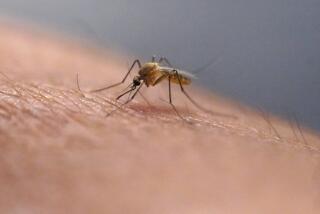Could Prove Useful in Combatting Mosquitoes : Protozoan Turns the Tables, Eats the Predator
- Share via
A one-celled creature that normally serves as a food source for mosquito larvae in rain-filled tree puddles can turn the tables on its predator by changing form and eating the larvae, UC Berkeley researchers said in a paper published today.
The new study is believed to be the first report of such a role reversal from prey to predator--the ultimate example of the best defense being a good offense.
Because of its ability to kill the larvae, the single-celled protozoan may prove useful as a biological agent to combat the Western tree mosquito, which carries the parasite that causes heart worms in dogs. It might also attack related mosquitoes that carry the viruses that cause yellow fever, encephalitis and other grave illnesses, entomologists Jan O. Washburn, John R. Anderson and their colleagues report in Science magazine.
“This could be a great asset” for mosquito control, said entomologist Richard Garcia of UC Berkeley, who is not part of the research group.
Passive Defenses
Most organisms that are preyed upon develop passive defenses, evolving disguises that allow them to blend into the scenery or learning to forage at night when fewer predators can see them. Microorganisms like the protozoa often develop more elaborate defenses, growing spines, jagged crests or hard capsules that make it more difficult for them to be eaten.
“But you can’t find a much better defense than hiding in--and eventually eating--your predator,” Anderson said.
The Berkeley researchers studied a protozoan called Lambornella clarki, a teardrop-shaped microorganism covered with tiny hairs that allow it to swim through puddles in search of even tinier bacteria and organic matter to feed on.
They found that when mosquito larvae hatch in water containing the protozoa, a kind of race begins to determine whether the mosquitoes or the protozoa will survive. For roughly the first 48 hours of their lives, the larvae are too small to eat the protozoa. But during this time, the larvae secrete a chemical--whose identity and normal function are still unknown--that causes a marked change in the protozoa.
Timing Is Everything
Over a period that also takes about 48 hours, the protozoa lose their mouth-like organs and assume a more spherical shape for attacking the larvae. If the change occurs soon enough, the protozoa kill the larvae. If it is not soon enough, the larvae prevail.
If the change occurs early, each protozoan swims around until it bumps into a larva, then attaches itself to the larval surface. It then forms a clear, protective cyst around itself, bores a hole into the body of the larva and squeezes inside.
If the larva is young, it will die and the protozoan will emerge in its original form, said entomologist David R. Mercer, a member of the Berkeley team. If the larva is older and larger, it may survive and develop into an infected adult mosquito. Infected female mosquitoes then deposit the protozoa--instead of their own eggs--into water-filled tree holes, starting the cycle anew.
“Interestingly, the infected female mosquitoes don’t look for blood meals,” Mercer said. “They don’t want to bite you.”
L. clarki has so far been shown to attack primarily the Western tree mosquito, which lives in holes in oaks and other hardwood trees along the northern Pacific Coast. That mosquito is a difficult pest to control, Garcia said, “because it is so hard to find the holes in the trees.”
Chemical Control
Fogging with chemical pesticides is used to control it, but the chemicals persist only for short periods and authorities are reluctant to use them heavily in populated areas, he added. “Any biological control method would be a big plus,” he said.
The protozoan could prove particularly valuable, Anderson said, because it is harmless to humans and other insects. Also, unlike most biological control agents, it can survive in the absence of the pest it controls. It would thus persist happily in a control area to await a new mosquito infestation.
Preliminary evidence suggests that L. clarki will also attack the Eastern tree mosquito, which is the primary carrier of the encephalitis virus in the United States, Mercer said. It may also attack the Asian tiger mosquito, which was introduced into the United States three years ago and which transmits yellow fever, he added.
Washburn is now in the field searching for other forms of the protozoan, Mercer said. The team hopes to find variants that can survive at higher temperatures and that thus might be useful in the Southern United States or in the tropics.






